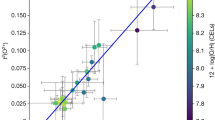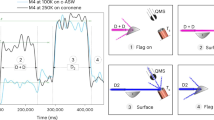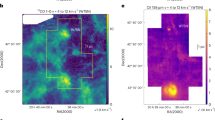Abstract
THE OAO 3 Copernicus ultraviolet satellite has provided important new data on the abundances of elements in the interstellar gas in the direction of many O and B-stars along lines of sight of low optical depth1–4. This information may make it possible to choose between the following theories of molecular hydrogen formation in interstellar clouds: (1) physical adsorption of H-atoms on to cold dielectric grains and their subsequent recombination and desorption5; (2) H2 recombination on graphite grains6; and (3) hydrogen recombination by non-activated chemisorption on transition metal grains7. Indirect methods of testing the above theories are essential because there is a glaring lack of experimental data, especially for processes (1) and (2). Also, it does not seem possible that in the near future radio astronomers will be able to measure the abundances of the various hydrogen ions (such as H2+ and H3+) that the above theories predict8.
This is a preview of subscription content, access via your institution
Access options
Subscribe to this journal
Receive 51 print issues and online access
$199.00 per year
only $3.90 per issue
Buy this article
- Purchase on Springer Link
- Instant access to full article PDF
Prices may be subject to local taxes which are calculated during checkout
Similar content being viewed by others
References
Morton, D. C., Drake, J. F., Jenkins, E. B., Rogerson, J. B., Spitzer, L. & York, D. G. Astrophys. J. 181, L103–L110 (1973).
Morton, D. C. Astrophys. J. 193, L35–L39 (1974).
York, D. G. Astrophys. J. 196, L103–106L (1975).
Snow, T. P. Jr. Astrophys. J. 204, 759–774 (1976).
Hollenbach, D. & Salpeter, E. E. Astrophys. J. 163, 155–164 (1971).
Barlow, M. J. & Silk, J. Astrophys. J. 207, 131–140 (1976).
Brecher, A. & Arrhenius, G. Nature phys. Sci. 230, 107–109 (1971).
De Jong, T. Astr. Astrophys. 20, 263–274 (1972).
Bond, G. C. Catalysis by Metals (Academic, London, 1962).
Tabak, R. G. Astrophys. Space Sci. 49, 41–46 (1977).
Barlow, M. J. & Silk, J. Astrophys. J. 211, L83–L87 (1977).
Shull, J. M., Hobbs, L. M. & York, D. G. Astrophys. J. 211, L139–L143 (1977).
Jenkins, E. J., Silk, J. & Wallerstein, G. Astrophys. J. Suppl. 32, 681–714 (1976).
Larimer, J. W. Geochim. cosmochim. Acta 31, 1215–1238 (1967).
Anders, E. Acct. chem. Res. 1, 289 (1968).
Cameron, A. G. W., Colgate, S. A. & Grossman, L. Nature 243, 204 (1973).
Field, G. B. Astrophys. J. 187, 453–459 (1974).
Cameron, A. G. W. Space Sci. Rev. 15, 121 (1973).
Czyzak, S. J. & Santiago, J. J. Astrophys. Space Sci. 23, 443–458 (1973).
Czyzak, S. J., Meese, J. M. & Santiago, J. J. Astrophys. J. 207, 425–431 (1976).
Author information
Authors and Affiliations
Rights and permissions
About this article
Cite this article
TABAK, R. Enhanced metal depletions and interstellar H2 abundances. Nature 269, 582–583 (1977). https://doi.org/10.1038/269582a0
Received:
Accepted:
Published:
Issue Date:
DOI: https://doi.org/10.1038/269582a0
Comments
By submitting a comment you agree to abide by our Terms and Community Guidelines. If you find something abusive or that does not comply with our terms or guidelines please flag it as inappropriate.



